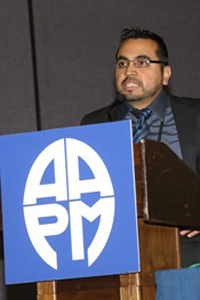Program Information
Interferometric Phase Shift Measurements to Determine the Absorbed Dose to Water
E Flores-Martinez1*, M Malin1, L DeWerd2, (1) UW- Madison, Madison, WI, (2) University of WI-Madison/ADCL, Madison, WI
TU-C-108-4 Tuesday 10:30AM - 12:30PM Room: 108Purpose: To investigate the feasibility of using phase shift measurements of visible light to determine the absorbed dose to water. To determine the minimum resolution of the optical system of a Michelson interferometer for measuring radiation induced changes in the temperature of water and to quantify the additional heating produced by the light.
Methods: A Michelson interferometer was modeled with a water-filled cell in one of its arms. The anticipated phase shift and temperature change was calculated for a 2 Gy irradiation. The observed change in intensity incident on the detector was calculated for different volumes of water and different doses. The heating of water caused by the laser was also estimated.
Results: The refractive index of water is related to the dose delivered with a proportionality constant of 2.14E-8 (λ=532 nm). For the modeled interferometer, the central spot signal in the detector arm is a function of the irradiated length of water and the dose delivered. Changes in intensity of 20 percent would be observed after a 2 Gy irradiation of a 20 cm long cell. Water heating due to the light beam is proportional to the laser power and the decadic absorption coefficient. For a 5 mW laser this would represent about 7.5 percent of the heating rate produced by a dose rate of 1 Gy/min.
Conclusion: We showed that visible light phase shift measurements are a reasonable approach to determine the absorbed dose to water. Heating due to the light could be reduced using higher dose rates and/or a pulsed laser. This model provides a measure of the average dose over the beam path and a tomographic reconstruction can be used to ascertain the dose to a point. The reconstructed 2D dose distribution can be useful for small fields in radiation therapy.
Contact Email:


